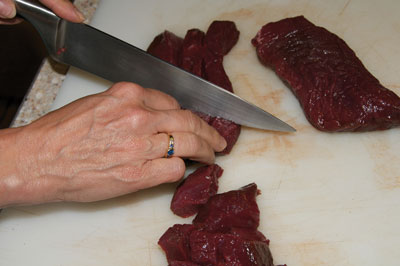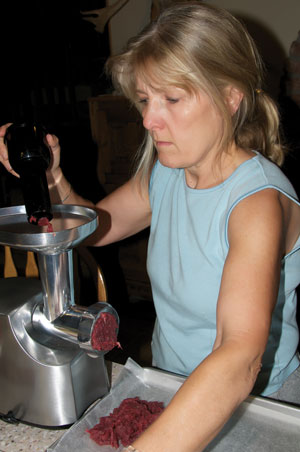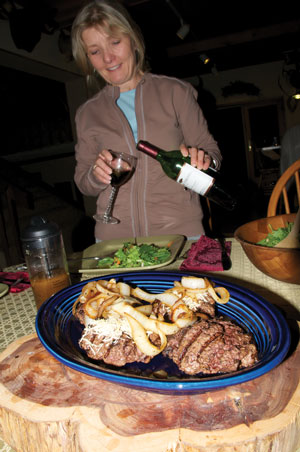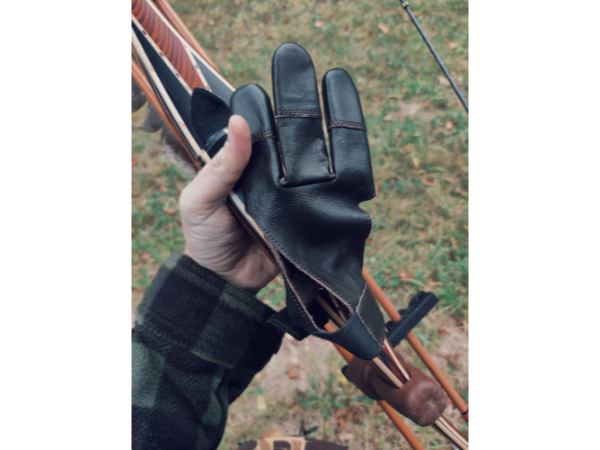An entire article on making a hamburger? I’m kidding, right? Wrong, and I’ll tell you why.
First, I feel strongly that eating what we shoot doesn’t get nearly the attention it deserves nowadays. Too many hunting magazines have devolved to endless streams of “grab-and-grin” hero photos separated by breathless prose descriptions of G-2s and record book scores. When was the last time you saw a picture of venison steaks in a hunting magazine?

Freeze the round in 2-pound chunks to prolong freezer life, then cut into 1-inch cubes just prior to grinding.
Of course I enjoy taking an exceptional animal, and I’ve even got a few antlers hanging on my wall to prove it. But I enjoy eating those animals just as much as I enjoy their horns, if not more. It’s my impression that as a group traditional bowhunters appreciate these core values more than most other segments of the outdoor community, and we should be proud of that. We also shouldn’t keep it a secret, since surveys consistently show that the non-hunting majority of American voters approves of hunting for food far more than they approve of “trophy hunting” (whatever that means).
Second, getting meat from the field to the dinner plate is a long, complicated process that leaves abundant opportunity to obtain less than ideal results. An unfortunate encounter or two with such results usually explains why so many people just don’t like to eat wild game (including a perplexing number of hunters).
Finally, you can’t make a silk purse out of a sow’s ear, and a dead deer contains plenty of the latter. I’m reminded of the story about the visiting dude who showed up at our local game processor with his first deer and asked the butcher to cut the whole thing up into T-bones. Life and ungulate anatomy just don’t work that way. I usually allocate the resources as follows: Loins — steaks, served as such. Round — Frozen as roasts (they freeze better that way), but cut into steaks, often to be sliced thin for Stroganoff, stir fry, etc. Rump — roasts. Everything else (the sow’s ears) — ground into burger or cut up into stew meat.
We make many dishes from that burger, from enchiladas and lasagna to meatloaf. But two or three times a month, I get an insatiable craving for a venison burger done right: cooked to medium rare, smothered in onions and sliced tomatoes, topped with melted cheese, and served between slices of French bread.
But there’s burger and there’s burger. Take a good, hard look at a specimen from a fast food chain sometime. In the first place, much of what lies within the bun isn’t even meat. I won’t distress my friends in the cattle business by pointing out what that meat has been through since it left their ranches. As a final insult, that ground beef has been mass processed and then smashed flat to achieve the comforting uniformity our society craves. And that, unfortunately, is what most of us have come to expect a burger to be.

Handle the venison delicately as it comes out of the grinder.
But there’s good news for us. High in protein, low in fat, and additive free, venison provides the best raw material imaginable for a burger. However, even if you send your carcass to a reputable processor in perfect condition, your ground meat may not come back that way. It’s almost impossible to commercially process ground meat without getting a little (or a lot) of someone else’s in the mix, and that unknown party may not have been as careful as you were with meat care in the field. Processors routinely add fat to ground meat unless you ask them not to, and then they usually do anyway. Finally, they routinely compress the burger for packaging.
And that’s a big deal, because every time you compress ground meat to make it fit into a package or form a perfect fast food shape, you make it harder to cook by eliminating its natural buoyancy and drying it out by squeezing away natural juices. (This is why you shouldn’t flatten a burger with a spatula when it’s in the pan.)
I still keep commercially ground venison burger in the freezer, because it serves the purpose well if I’m making tacos or some such. But for that absolutely perfect twice a month venison burger, consider taking the following steps:
Buy your own high quality meat grinder. You can get a great one for a couple of hundred bucks. If you use it to grind all of your burger and split the cost with a hunting partner, it will pay for itself in a year or two (unless you experience a shooting slump, in which case this article won’t help you).
- Cut two pound chunks of round and freeze them as roasts.
- Thaw the meat slowly in the refrigerator beginning a day before you plan to use it.
- Shortly before you plan to start cooking, cut the meat into pieces no more than 1” on a side. This will be easiest to do if the meat is still partially frozen. Trim as much sinew and gristle as possible away as you cut.
- Feed the fully thawed chunks into the grinder, set to coarse. Let the ground meat spill out onto a greased cookie sheet while handling it as little as possible, so it retains its natural “fluffiness”. Don’t grind more meat than you plan to eat that day.
- Gently spread the ground meat out on the sheet and refrigerate it for an hour. Then drizzle it with melted butter, approximately 2 tbsp. per pound of meat. This will add flavor, help the outside of the burger sear to a crust, and keep the patty intact.
- Using the tips of your fingers, gently work the ground meat into burger-sized portions without compressing it. Don’t worry if the burgers look round rather than flat.
- Sear the burgers over medium-high heat in a greased pan for two minutes on a side. Turn them just once, and resist the urge to smash them flat with the spatula.

The finished product: venison burgers that deserve a toast!
- Finish the burgers in an oven pre-heated to 300 degrees for approximately five minutes. The exact timing will vary according to your own taste. Use a meat thermometer for precision, aiming for an interior temperature of 125 degrees for rare, 135 for medium.
- Serve any way you’d serve a good burger, according to personal preference in sauces and accompaniments.
This method obviously takes more effort than cutting off a chunk of packaged ground venison and throwing it in a pan. It helps if you like to cook, have hunting partners and their families in the kitchen while you’re cooking, and can enjoy a good glass of wine during the process. But like hunting and life itself, the quality of the final result reflects the effort invested.







Leave A Comment